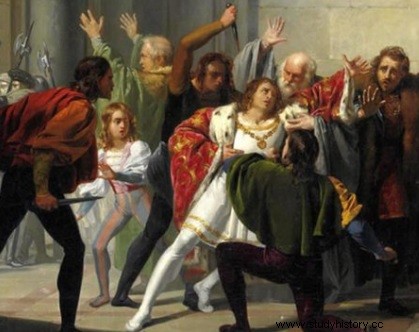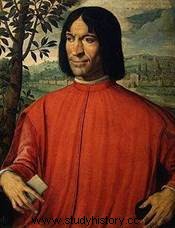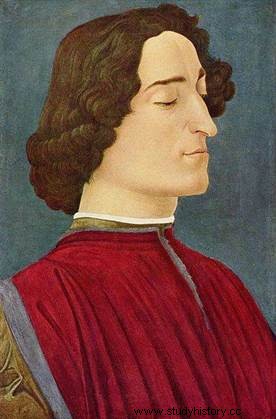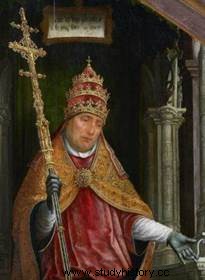 In universal history, plots, conspiracies and attacks were numerous, sometimes changing the course of things . The Pazzi Conspiracy , which took place in Florence in 1478 , is the typical example of a failed political plot in modern times. Angel Politian , intellectual and renowned member of the Florentine chancellery, close to Laurent de Medici , notably wrote the story of this conspiracy, which considerably upset the Medici and their way of apprehending and exercising power within the Florentine Republic. From then on, following the failure of the Pazzi conspiracy , the Medici enter into legend, and Laurent de Medici becomes the "Magnificent".
In universal history, plots, conspiracies and attacks were numerous, sometimes changing the course of things . The Pazzi Conspiracy , which took place in Florence in 1478 , is the typical example of a failed political plot in modern times. Angel Politian , intellectual and renowned member of the Florentine chancellery, close to Laurent de Medici , notably wrote the story of this conspiracy, which considerably upset the Medici and their way of apprehending and exercising power within the Florentine Republic. From then on, following the failure of the Pazzi conspiracy , the Medici enter into legend, and Laurent de Medici becomes the "Magnificent".
Pazzi versus Medici:an “ideological” conflict?
Historically, the Pazzi opposed the Medici . Originally from Val d'Arno, between Pisa and Arezzo, the Pazzi are great nobles and landowners. In this sense, they possessed, in the 15th century, numerous fiefdoms in Tuscany. Even more, it is a prestigious family, which is an integral part of the Florentine urban nobility. For example, the ancestor Pazzino de Pazzi is known to have been the first knight to enter the city of Jerusalem, in 1099 , at the time of the First Crusade .
At the end of this crusade, relics were brought back to the West, which are also at the origin of the feast of "Scoppio del Body in Florence, in other words the "explosion of the tank". Once back in Florence, in 1101 , Pazzino di Pazzi was celebrated, and his family gained amply in respectability and renown. The Pazzi are therefore, in a way, the incarnation of the "old aristocracy" of the city of Florence, where they have been installed for several centuries - at least since the 11th century, the oldest member of the line being Ranieri de Pazzi . Therefore, from the beginning of the twelfth century, the Pazzi accumulate a great fortune, distinguished by their commercial and financial activity. In the 15th century, the reputation of the lineage was well established, especially when Andrea Pazzi commissioned the famous Florentine architect Filippo Brunelleschi , in 1429 , a chapel, built in the Basilica of Santa Croce in Florence.
 The Pazzi increasingly opposed the Medici , in the course of the fifteenth century. The Medici had only recently been established in Florence, since around the 13th century. They are a family of modest extraction, a line of merchants and wool workers – the adversaries of the Medici did not fail to remind them. Originally from the Apennines, and more precisely from the Mugello region, the Medici emigrated to Florence in the 13th century, at a time when the Republic was at the height of its power.
The Pazzi increasingly opposed the Medici , in the course of the fifteenth century. The Medici had only recently been established in Florence, since around the 13th century. They are a family of modest extraction, a line of merchants and wool workers – the adversaries of the Medici did not fail to remind them. Originally from the Apennines, and more precisely from the Mugello region, the Medici emigrated to Florence in the 13th century, at a time when the Republic was at the height of its power.
The first ones to settle then go into finance. They were imitated by the famous Giovanni di Bicci , who, by founding the bank of the Medici in 1397 , truly launched the fame of the family. His son, Cosimo the Elder , was otherwise considered the "Pater Patriae by the Florentines, as the "Father of the Fatherland". He opposed the old Florentine oligarchy, which held power in Florence, and was eventually exiled to Venice in 1433 by Rinaldo Albizzi , leader of the oligarch faction. A year later, in 1434 , Cosimo the Elder returned to Florence, banished his rival, and seized power by becoming gonfalonier, that is to say head of government. It was therefore through banking, and the relatively rapid acquisition of funds, that the Medici were able to seize power in Florence.
The Pazzi saw the Medici with a bad eye. How could a family, of modest and recent extraction, manage to settle in the heart of the urban patriciate, to drive out the old oligarchic practices and to install its power? The Pazzi , who were fundamentally attached to their roots and to the Florentine oligarchic heritage, considered the advent of the Medici as an insult to the Republic. It is for all these reasons that the Pazzi , in 1478 , fomented a conspiracy, a conspiracy, which we can qualify as a “coup d’etat”. This is an ideological opposition, between the oligarchy stripped of its prerogatives and the rise of new patrician families, which turns out to be at the heart of the Pazzi conspiracy . This phenomenon, typically Italian, seems to be inherent in the urban and republican patriciates, Italian, in modern times – the Republic of Venice, in the sixteenth and seventeenth centuries, notably experienced similar difficulties.
The times of the Pazzi conspiracy
 The Pazzi Conspiracy corresponds, in reality, to two “times”, to two great moments. First of all, it is necessary to mention the modalities, the main guidelines. The goal of the Pazzi , and more particularly of Francesco de Pazzi , was simple:it was a question of "decapitating" the family of the Medici , by assassinating Julian de Medici and his brother Laurent , who at that time governed the city of Florence. More than contesting Medicean hegemony in Florence, it was, for the Pazzi , to annihilate the power of this line for the benefit of their own, and to restore within the Republic the fundamental principles of an oligarchic government, held by the noblest and oldest families of the city.
The Pazzi Conspiracy corresponds, in reality, to two “times”, to two great moments. First of all, it is necessary to mention the modalities, the main guidelines. The goal of the Pazzi , and more particularly of Francesco de Pazzi , was simple:it was a question of "decapitating" the family of the Medici , by assassinating Julian de Medici and his brother Laurent , who at that time governed the city of Florence. More than contesting Medicean hegemony in Florence, it was, for the Pazzi , to annihilate the power of this line for the benefit of their own, and to restore within the Republic the fundamental principles of an oligarchic government, held by the noblest and oldest families of the city.
The Pazzi were able to find an ally of choice, in the person of Pope Sixtus IV . Francesco della Rovere , elected pope in 1471 as Sixtus IV , a convinced nepotist, wanted to give his nephew, Girolamo Riario , the towns of Faenza and Imola, in Florentine territory. This was without taking into account the firmness of the Medici , who refused to see their territory alienated in favor of the nephew of a reputedly promiscuous pope. Sixtus IV therefore sought internal support in Florence, which he found in the person of Francesco de Pazzi . This is how the idea of the conspiracy was born, in the conjunction of pontifical and “Pazzian” reflections.
The first great moment of the Pazzi Conspiracy took place on Saturday April 25, 1478 . Francesco de Pazzi then planned to assassinate Julien and Laurent de Medici during a banquet, which had been organized at the Villa Medici in Fiesole, near Florence, to celebrate the election to the cardinalate of Raffaele Riario , nephew of … Sixtus IV . More specifically, it was about poisoning the two brothers during the party. The Pazzi were able to attend this banquet due to their recent union with the Medici family :indeed, the sister of Laurent and Julian de Medici , Bianca de' Medici , had just married Guglielmo de Pazzi . However, the assassination attempt could not succeed, since Julian de Medici , indisposed, did not go to the banquet. The plot therefore had to be postponed. In this case, the next day.
 The second great moment of the Pazzi conspiracy therefore took place on Sunday April 26 1478 , Easter Day. Cardinal Riario then gave a mass in the Duomo of Florence, in other words in the Basilica of Santa Maria del Fiore, in thanks for the banquet given the day before. All Saturday guests were therefore invited to go to the Basilica, which Laurent de Medici fit. The Medici and the conspirators therefore went, jointly, to mass, while the first did not yet know what was going to happen. Nevertheless, Julian de Medici was still indisposed, and did not go to mass right away. Bernardo Bancini , sicarius, and Francesco de Pazzi went to get Julian de Medici home, to take him to the Basilica, where mass had already begun!
The second great moment of the Pazzi conspiracy therefore took place on Sunday April 26 1478 , Easter Day. Cardinal Riario then gave a mass in the Duomo of Florence, in other words in the Basilica of Santa Maria del Fiore, in thanks for the banquet given the day before. All Saturday guests were therefore invited to go to the Basilica, which Laurent de Medici fit. The Medici and the conspirators therefore went, jointly, to mass, while the first did not yet know what was going to happen. Nevertheless, Julian de Medici was still indisposed, and did not go to mass right away. Bernardo Bancini , sicarius, and Francesco de Pazzi went to get Julian de Medici home, to take him to the Basilica, where mass had already begun!
The latter did not yet know that he was going to be assassinated by the two characters who accompanied him to the holy place. At the solemn moment of elevation, Bandini stabbed Julian de Medici nineteen times who, kneeling and already weakened by a wound in the leg, succumbed. Laurent de Medici , accompanied by the faithful Ange Politien , and copyrighted by Andrea and Laurent Cavalcanti , was wounded, but managed to escape, reaching the sacristy of the Basilica of Santa Maria del Fiore. In his flight, Laurent de Medici was protected by Francesco Nori , who sacrificed his life to save the last representative of the Medici family . The Pazzi Conspiracy , supported by the Pope of Sixtus IV , failed, after aborting the first time.
The consequences of the failure of the plot
As one can easily imagine, the consequences of such an event were enormous. Jacopo de Pazzi who, while Laurent de Medici fled the Duomo, went to Signoria Square, believed that the Florentine people would support him and help him overthrow power. It did not happen. Despite the “Libertà! which he bludgeoned towards the crowd, with his companions the Florentines assailed the conspirators and pursued them. The people of Florence condemned, therefore, and from the beginning of the events, an impure gesture, uttered on the holiest day of Christianity. Jacopo de Pazzi managed to escape, and brought the news of the failure of the conspiracy to the papal troops, who were posted all around Florence. Fearing certain reprisals, the troops did not attack, and ended up retreating.
 The Pazzi Conspiracy was fatal for the eponymous family and for their allies. Once Laurent de Medici arrived in a safe place, and once he was assured of the support of his people in the face of the horror of this plot, a real manhunt, and in this case "for the Pazzi was organized in Florence. They had to be found as quickly as possible and condemned. Francesco de Pazzi , the “mastermind” of the conspiracy, was hanged, naked, from a window of the Palazzo Vecchio of Florence, the political and nerve center of the city. Jacopo de Pazzi was found a few days later and murdered, his body being thrown into the Arno, the river that runs through the city of Florence. Bernardo Bandini , who initially managed to flee the city and reach Constantinople, was found by the Florentines, brought back to Florence and tried, a year and a half later, on December 29, 1479 . He was beheaded, and his corpse was notably drawn by Leonardo da Vinci .
The Pazzi Conspiracy was fatal for the eponymous family and for their allies. Once Laurent de Medici arrived in a safe place, and once he was assured of the support of his people in the face of the horror of this plot, a real manhunt, and in this case "for the Pazzi was organized in Florence. They had to be found as quickly as possible and condemned. Francesco de Pazzi , the “mastermind” of the conspiracy, was hanged, naked, from a window of the Palazzo Vecchio of Florence, the political and nerve center of the city. Jacopo de Pazzi was found a few days later and murdered, his body being thrown into the Arno, the river that runs through the city of Florence. Bernardo Bandini , who initially managed to flee the city and reach Constantinople, was found by the Florentines, brought back to Florence and tried, a year and a half later, on December 29, 1479 . He was beheaded, and his corpse was notably drawn by Leonardo da Vinci .
Laurent de Medici , furious, did absolutely nothing to calm his people. All members of the Pazzi family were arrested, even exiled, and their property was confiscated by the Republic. They are also prohibited from having their names appear on official documents. The pope reacted firmly, at first, by excommunicating the entire city of Florence. But, faced with the firmness of the Florentines, he had to give up. Laurent de Medici , for his part, therefore enjoyed increased prestige and fame, which enabled him to considerably strengthen his power within the Republic. For example, he reduced the communal assembly to seventy members, chosen from among his entourage and the people he considered trustworthy.
Angel Politian , close to Laurent de Medici and member of the Republican Chancellery, wrote a history of the Pazzi conspiracy . This event is considered, for Florence, as the affirmation of the power of the Medici . It is interesting to observe how a failed attack allows the beleaguered family to come out on top, and to increase their power. Nevertheless, in 1494 , the coming to power of Jérôme Savonarola in power in Florence, after driving out the Medici , restores the Pazzi in their prerogatives and privileges. But the fall of Savonarola , in 1498 , and the return of the Medici , resulted in restoring the initial situation.
Bibliography
- DELUMEAU Jean, Italy from the Renaissance to the end of the 18th century ᵉ century , Paris, Armand Colin, 1997.
- LANG Jack, Laurent the Magnificent , Paris, Tempus, 2004.